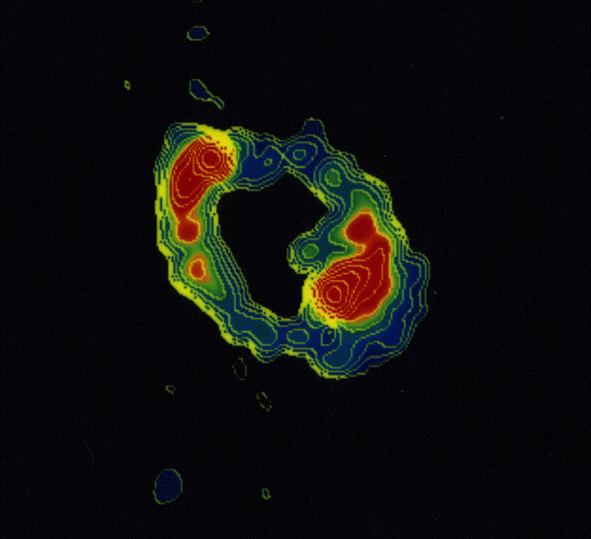The first compound gravitational lens?
In 1991 the source PKS 1830-211 was identified as an unusually strong, ~ 10 Jy, radio Einstein ring (gravitational lens). But it now appears that there may be two separate lensing galaxies involved, not one. This would make PKS 1830-211 the first compound gravitational lens.

PKS 1830-211 (MERLIN image at 5 GHz)
PKS 1830-211 is certainly an extragalactic gravitational lens, but it lies in a crowded and obscured field close to the Galactic Centre, and neither the lensing galaxy nor the lensed object has been identified optically. In June 1995 a search was made for radio absorption lines associated with the source, using the Parkes telescope equipped with the wideband receiver built for Project Phoenix. A single, weak absorption line was found at 1.19 GHz. The spectrum showed no other features, but the line had all the characteristics of HI absorption. If interpreted as HI absorption, the line gave a redshift for the absorbing object ­p; presumably the lensing galaxy ­p; of 0.19. Observations with the Australia Telescope Compact Array confirmed the detection of the line and showed that the absorption was centred on the lens.
However, in June 1995 Wiklind and Combes observed PKS 1830-211 with SEST (the Swedish-ESO Submillimeter Telescope) and detected several molecular absorption features, which gave a redshift of 0.89. This they presumed to be the redshift of the lens.
No single intervening galaxy can account for the two redshifts. It appears, therefore, that there are two galaxies along the line of sight to the background source, one 4.5 times more distant than the other, both contributing to the lensed image.
If this were so then the degree of absorption would vary across the lensed image. To test this idea J. Lovell et al. made a spectral-line VLBI image of the source at 1.19 GHz, using the Australia Telescope Compact Array in its phased-array mode for maximum sensitivity, and the Mopra, Parkes and Hobart antennas. The resulting image, with two absorption profiles, appears on the opposite page. The absorber covers the north-east component of the source.
There is other evidence to corroborate the hypothesis of a compound lens. Higher-resolution VLBI images, made over three years, show that the Einstein ring's two compact components have significantly different morphologies. This is hard to explain if they are simply twin images produced by a single lensing object.
J. Lovell, P. McCulloch (Uni. Tasmania); R. Gough, D. Jauncey, E. King, J. Reynolds, A. Tzioumis (ATNF); R. Preston (JPL)
More:
News
Public
